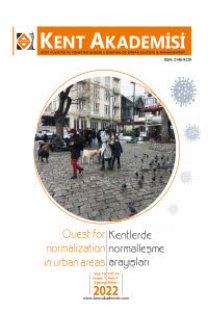“Hosseiniyeh”; İran Geleneksel Kentlerinde Bir Ara Mekan
Ara Mekân, Hosseiniyeh, Geleneksel İran Şehri, Mahalle Meydanı, Taziyeh
“Hosseiniyeh”; An In-between Space in the Iranian Traditional Cities
___
- Alexander, C. (1977). A pattern language: towns, buildings, construction. Oxford university press.
- Ayoub, M. (1978). Redemptive Suffering in Islam: A Study of the Devotional Aspects of ‘Âshûra’in Twelver Shi’ism. The Hague, the Netherlands. cited in: http://www.iranicaonline.org/articles/asura
- Balilan, L. Etesam, I. Eslami, S.G. (2011). In Persian: Nagshe Fazaye Beynabeyn dar Hoviyyat Bakhshi be Gostareye Fazaiye Bafthaye Tarikhiye Iran [The Role of In-between Space in Creating the Spatial Character of Historic Urban Fabric of Iran]. Hoviyyate Shahr. 8. 5. 59-71
- Beeman, W. O. (1981). A Full Arena: The Development and Meaning of Popular Performance Traditions in Iran: The Dialectics of Continuity and Change. In Modern Iran: the dialectics of continuity and change (pp. 361-382). State University of New York Press.
- Chelkowski, P. J. (1977). Ta'ziyeh: Indigenous Avant-Garde Theatre of Iran. Performing Arts Journal, 2(1), 31-40.
- Dennis, R. (2008). Cities in modernity: representations and productions of metropolitan space, 1840-1930. Cambridge University Press.
- Gehl, J. (1987). Life between buildings (Vol. 23). New York: Van Nostrand Reinhold.
- Kiani Bidgoli, S., & Fatehi, A. (2019). A comparison of Elements in Performing Naqqali (Iranian Dramatic Storytelling) and Ta’zieh (Shi’ites Passion play/Condolence Theater). Rhetoric and Grammar Studies, 9(15), 193-229.
- Laiprakobsup, N. (2007). Inbetween place: The emergence of the essence. Texas A&M University.
- Nakash, Y. (1993). An Attempt to Trace the Origin of the Rituals of Āshurā. Die Welt des Islams, 33(2), 161-181.
- Oggiano, F. (2016). The Articulations of the In-between Realm in Sardinia. Journal of Civil Engineering and Architecture, 10, 629-642.
- Ramezani, S., & Hamidi, S. (2010). Privacy and social interaction in traditional towns to contemporary urban design in Iran. American Journal of Engineering and Applied Sciences, 3(3), 501-508.
- Rezaei Badafshani M. (2007) Small and sustainable spaces, in: Techniques and technologies for sustainability: proceedings: international conference and summer school, editor: Adrian Atkinson, Berlin, ISR Sonderpublikation, 138-48
- Roemer, H. R. (1986). The Safavid Period. The Cambridge History of Iran, 6, 189-350.
- Salingaros, N. A. (2000). Complexity and urban coherence. Journal of urban design, 5(3), 291-316.
- Soltanzadeh, H. (1993). in Persian: Fazahaye Vurudi dar Memariye Sonnatiye Iran [The entrances and its spatial features in the traditional architecture of Iran]. Shahrdari publication, Tehran
- Stavrides, S. (2010). Towards the City of Thresholds. CreativeCommons Publication
- Stevens, Q. (2006). Betwixt and between: Building thresholds, liminality and public space. In Loose Space (pp. 73-92). Routledge.
- Tavassoli, M. (1990). In Persian: Mabani ve teknikhaye tarrahi shahri dar Iran. [Principles and Techniques of Urban Design in Iran]. Urban Planning and Architectural Research Centre of Iran, Ministry of Housing and Urban Development, Iran
- Tavassoli, M., & Bonyadi, N. (1992). In Persian: Tarahiye Fazaye Shahri 1&2 [Urban Space Design 1&2]. Urban Planning and Architecture Research Centre of Iran, Tehran.
- Trancik, R. (1991). Finding lost space: theories of urban design. John Wiley & Sons.
- Van Eyck, A. (1968). Team 10 Primer, ed. Alison Smithson (Cambridge: MIT Press), p. 104.
- ISSN: 2146-9229
- Yayın Aralığı: Yılda 4 Sayı
- Başlangıç: 2008
- Yayıncı: Karadeniz Yazarlar ve Şairler Derneği
Seçim Bildirgelerinin Sosyal Politika Açısından Değerlendirilmesi: Merkez-Yerel Karşılaştırması
Değirmencik Köyünün (Safranbolu) Kırsal Turizm Potansiyelinin Araştırılması
Nurhan KOÇAN, Merve OZEREN ALKAN, Erden AKTAŞ, Ferdi KÖSEOĞLU
Covid-19 Salgını Sürecinde Belediyelerde Sosyal Hizmet Uygulamaları
İstanbul İli Tekne Bağlama Kapasiteleri ve Bağlama Kütüğüne Kayıtlı Tekne Sayılarının Analizi
Kent İçi Ulaşımda Bisiklet Ağının Oluşturulması: Elazığ Örneği
İç Mekanda Bitkisel Tasarım Yaklaşımları Üzerine Bir Stüdyo Deneyimi
Kırsal Yerleşmelerde Konut Eklentilerinin Bilecik Tongurlar Köyü Üzerinden İrdelenmesi
Didem BARAN ERGÜL, Dilek EKŞİ AKBULUT
Sürdürülebilir Malzemeler Bağlamında Kent Mobilyaları
Elif ŞATIROĞLU, Deryanur DİNÇER, Bengi KORGAVUŞ
Manisa Hatuniye Camisi ve 15. ve 16. Yüzyıl Manisa Camileri İçindeki Yerine Yönelik Bir Araştırma
Melis KARACA SERT, Yener ALTIPARMAKOĞULLARI, Aysem Gulin BASAR
